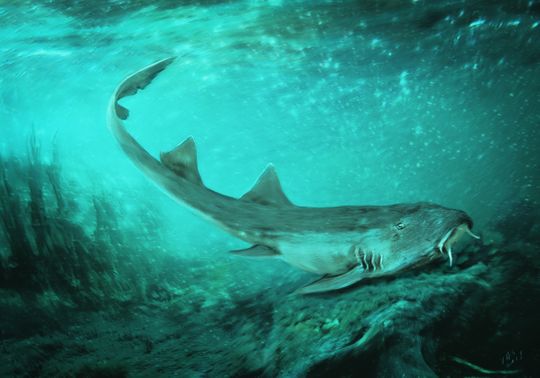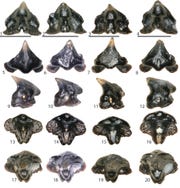
The discovery rested for decades inside leftover sediment in the basement of Chicago’s Field Museum: A shark with triangular teeth shaped like spaceships in an old-school video game.
The tiny, flat-headed shark swam in a river flowing some 67 million years ago in modern-day South Dakota, scientists say, before resting next to a Tyrannosaurus rex with the largest skeleton ever discovered.
A museum volunteer named Karen Nordquist was scanning the sediment once found alongside SUE, the Field Museum’s famous T. rex, when she noticed something, the museum said in a release: Teeth shaped like the pixelated spaceships from the 1980s game “Galaga.”
The newly discovered shark was named Galagadon nordquistae, after both “Galaga” and Nordquist, a retired chemist. A paper describing the shark appeared this week in The Journal of Paleontology.
“These teeth are the size of a sand grain,” said Terry Gates, a paleontologist at North Carolina State University and co-author of the paper, in a statement. “Without a microscope you’d just throw them away.”

Images of teeth from the Galagadon nordquistae
The shark’s skeleton, made of cartilage, was not preserved, co-author Pete Makovicky, the Field Museum’s curator of dinosaurs, told the museum. But its tiny teeth — only a millimeter wide — point to a similarly small shark.
“Galagadon was less than two feet long — it’s not exactly Jaws,” Makovicky said in a statement, adding that the fish likely “had a flat face and was very likely camouflage-colored, since its relatives today have a camouflage pattern.”
The shark’s craggy teeth didn’t sink into any T. rex flesh, Gates noted, but was more suitable for smashing a river’s crawdads and snails.
Still, its discovery so near a T. Rex has made scientists rethink what they knew about the area where SUE lived.
“It amazes me that we can find microscopic shark teeth sitting right beside the bones of the largest predators of all time,” Gates said in the statement.
Every new discovery from the Cretaceous period — no matter how small — enriches scientists’ understanding of that time, he said.
“There is no way for us to understand what changed in the ecosystem during the mass extinction at the end of the Cretaceous without knowing all the wonderful species that existed before,” Gates said.





























